Page 1088 of 4264
8A-430 ELECTRICAL-BODY AND CHASSIS
No. Connector face No. Connector face
E-54
(6VE1)
Ignition coil E-62
(6VE1)
Cam position sensor
E-54
(4JH1-TC)
Black A/T term ASM E-64
(C24SE)
(6VE1)
Oil pressure switch (P/STRG)
E-55
(6VE1)
Ignition coil E-65
(C24SE)
(6VE1)
Thermo unit
E-56
(6VE1)
Ignition coil E-66
(C24SE)
(6VE1)
Duty solenoid
E-57
(6VE1)
Ignition coil E-67
NOT USED
E-58
(6VE1)
Ignition coil E-68
(C24SE)
Throttle position sensor
E-59
(C24SE)
(6VE1)
(6VE1) Crank position sensor (C24SE) E-68
(6VE1)
Throttle position sensor
E-60
(C24SE)
ECM E-69
(6VE1)
Temperature sensor
E-60
(6VE1)
ECM-A E-70
(C24SE)
IACV
E-61
(6VE1)
ECM-B E-70
(6VE1)
IACV
Page 1089 of 4264
ELECTRICAL-BODY AND CHASSIS 8A-431
No. Connector face No. Connector face
E-71
NOT USED E-80
(6VE1)
Cylinder revolution
E-72
(C24SE)
(6VE1)
Engine earth-A E-81
(6VE1)
Speed sensor
E-73
(6VE1)
Engine earth-A E-82
(6VE1)
Transmission wire
E-74
(C24SE)
(6VE1)
Engine earth-B E-83
(6VE1)
Oil temperature sensor
E-75
(C24SE)
(6VE1)
Oil pressure switch E-84
(C24SE)
Knock sensor
E-76
(6VE1)
EGR valve E-85
(C24SE)
MAP sensor
E-77
(C24SE)
O2 sensor E-86
(4JA1-L)
SilverThermo switch; QOS
E-77
(6VE1)
O2 sensor RH-Front E-87
(4JA1-L)
WhiteSolenoid CSD
E-78
(6VE1)
O2 sensor LH-Front E-88
(4JA1-L)
SilverThermo switch; EGR
E-79
(6VE1)
Neutral start switch E-89
(4JA1-L)
White
Immobilizer engine control unit
Page 1167 of 4264
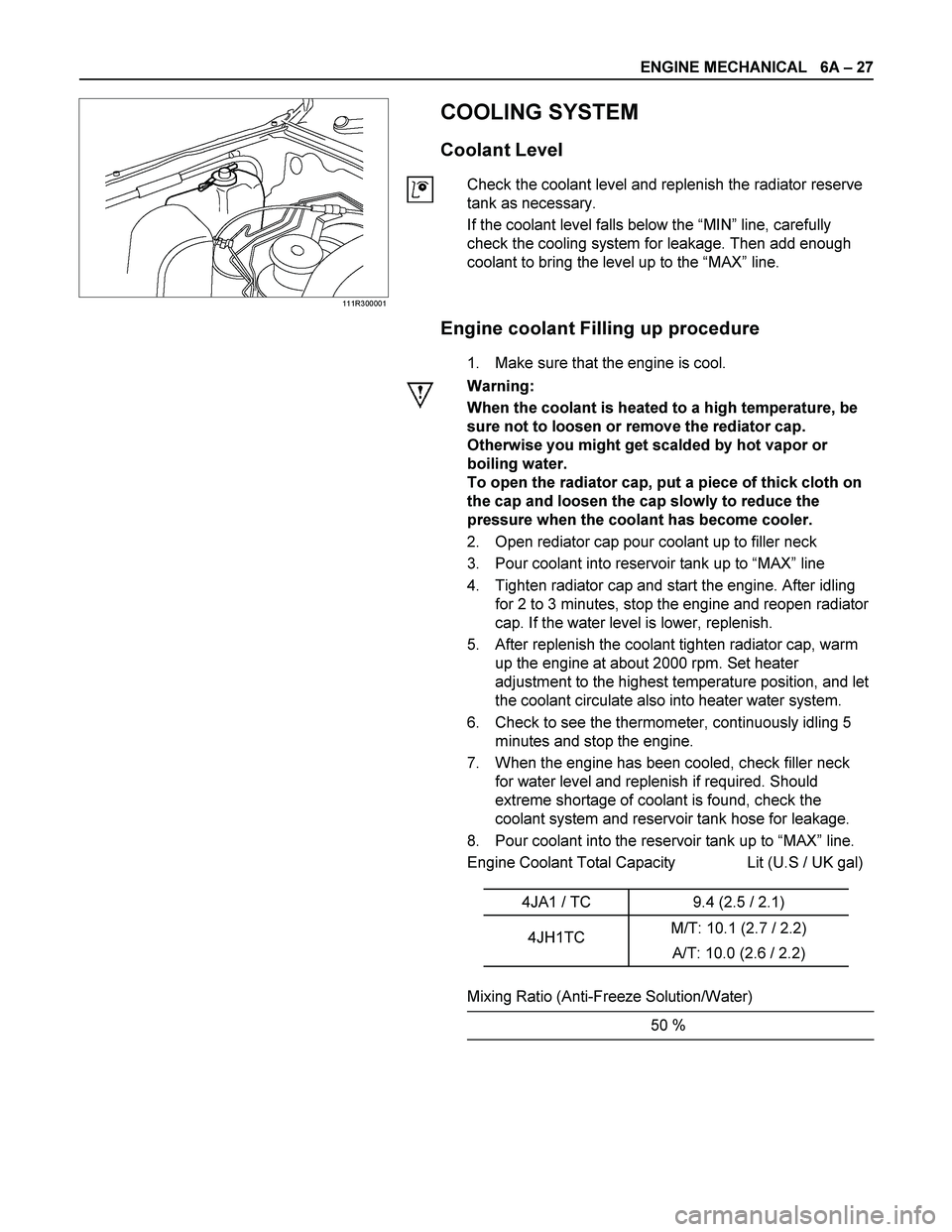
ENGINE MECHANICAL 6A – 27
111R300001
COOLING SYSTEM
Coolant Level
Check the coolant level and replenish the radiator reserve
tank as necessary.
If the coolant level falls below the “MIN” line, carefully
check the cooling system for leakage. Then add enough
coolant to bring the level up to the “MAX” line.
Engine coolant Filling up procedure
1. Make sure that the engine is cool.
Warning:
When the coolant is heated to a high temperature, be
sure not to loosen or remove the rediator cap.
Otherwise you might get scalded by hot vapor or
boiling water.
To open the radiator cap, put a piece of thick cloth on
the cap and loosen the cap slowly to reduce the
pressure when the coolant has become cooler.
2. Open rediator cap pour coolant up to filler neck
3. Pour coolant into reservoir tank up to “MAX” line
4. Tighten radiator cap and start the engine. After idling
for 2 to 3 minutes, stop the engine and reopen radiator
cap. If the water level is lower, replenish.
5. After replenish the coolant tighten radiator cap, warm
up the engine at about 2000 rpm. Set heater
adjustment to the highest temperature position, and let
the coolant circulate also into heater water system.
6. Check to see the thermometer, continuously idling 5
minutes and stop the engine.
7. When the engine has been cooled, check filler neck
for water level and replenish if required. Should
extreme shortage of coolant is found, check the
coolant system and reservoir tank hose for leakage.
8. Pour coolant into the reservoir tank up to “MAX” line.
Engine Coolant Total Capacity Lit (U.S / UK gal)
4JA1 / TC 9.4 (2.5 / 2.1)
4JH1TC M/T: 10.1 (2.7 / 2.2)
A/T: 10.0 (2.6 / 2.2)
Mixing Ratio (Anti-Freeze Solution/Water)
50 %
Page 1169 of 4264
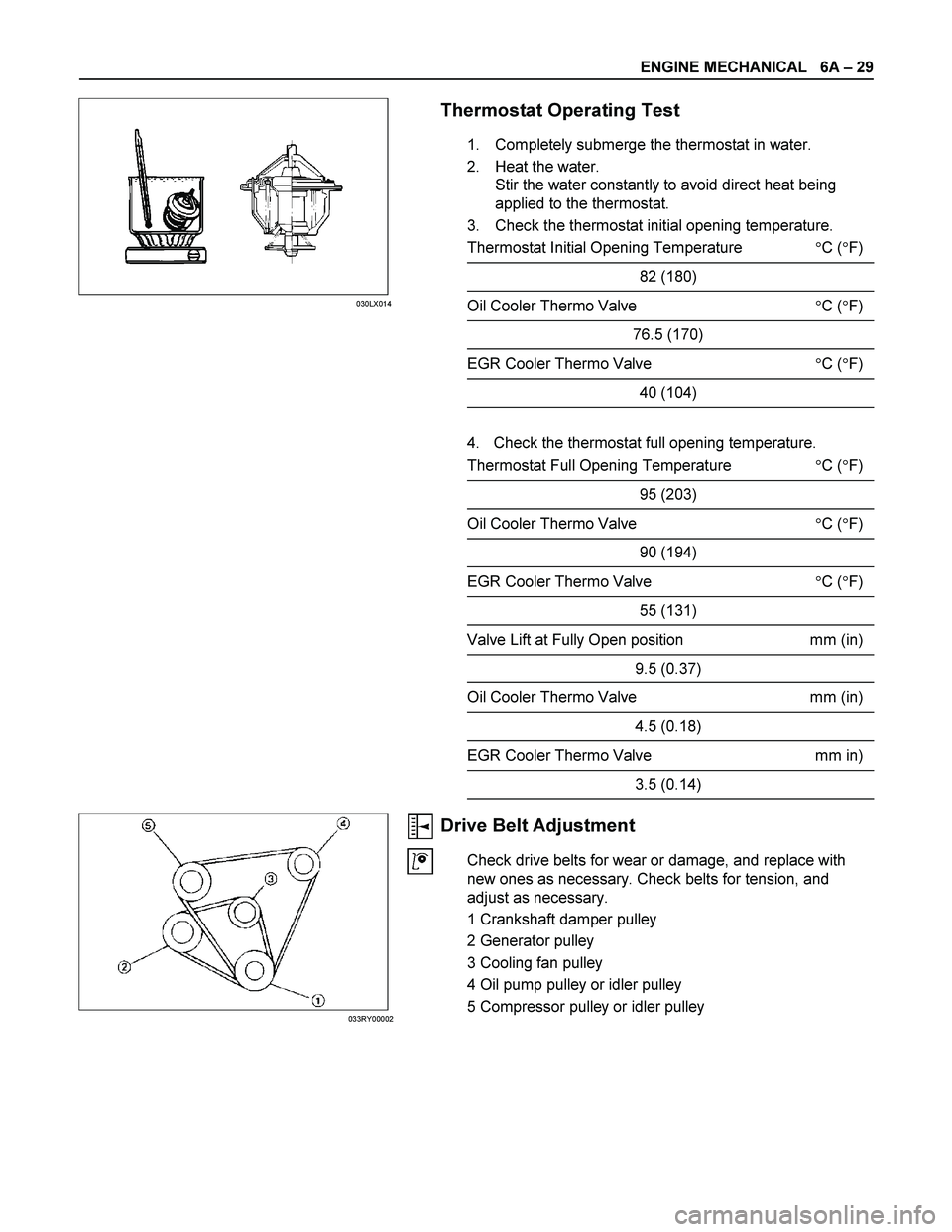
ENGINE MECHANICAL 6A – 29
Thermostat Operating Test
1. Completely submerge the thermostat in water.
2. Heat the water.
Stir the water constantly to avoid direct heat being
applied to the thermostat.
3. Check the thermostat initial opening temperature.
Thermostat Initial Opening Temperature �C (�F)
82 (180)
Oil Cooler Thermo Valve �C (�F)
76.5 (170)
EGR Cooler Thermo Valve �C (�F)
40 (104)
4. Check the thermostat full opening temperature.
Thermostat Full Opening Temperature �C (�F)
95 (203)
Oil Cooler Thermo Valve �C (�F)
90 (194)
EGR Cooler Thermo Valve �C (�F)
55 (131)
Valve Lift at Fully Open position mm (in)
9.5 (0.37)
Oil Cooler Thermo Valve mm (in)
4.5 (0.18)
EGR Cooler Thermo Valve mm in)
3.5 (0.14)
Drive Belt Adjustment
Check drive belts for wear or damage, and replace with
new ones as necessary. Check belts for tension, and
adjust as necessary.
1 Crankshaft damper pulley
2 Generator pulley
3 Cooling fan pulley
4 Oil pump pulley or idler pulley
5 Compressor pulley or idler pulley
030LX014
033RY00002
Page 1181 of 4264
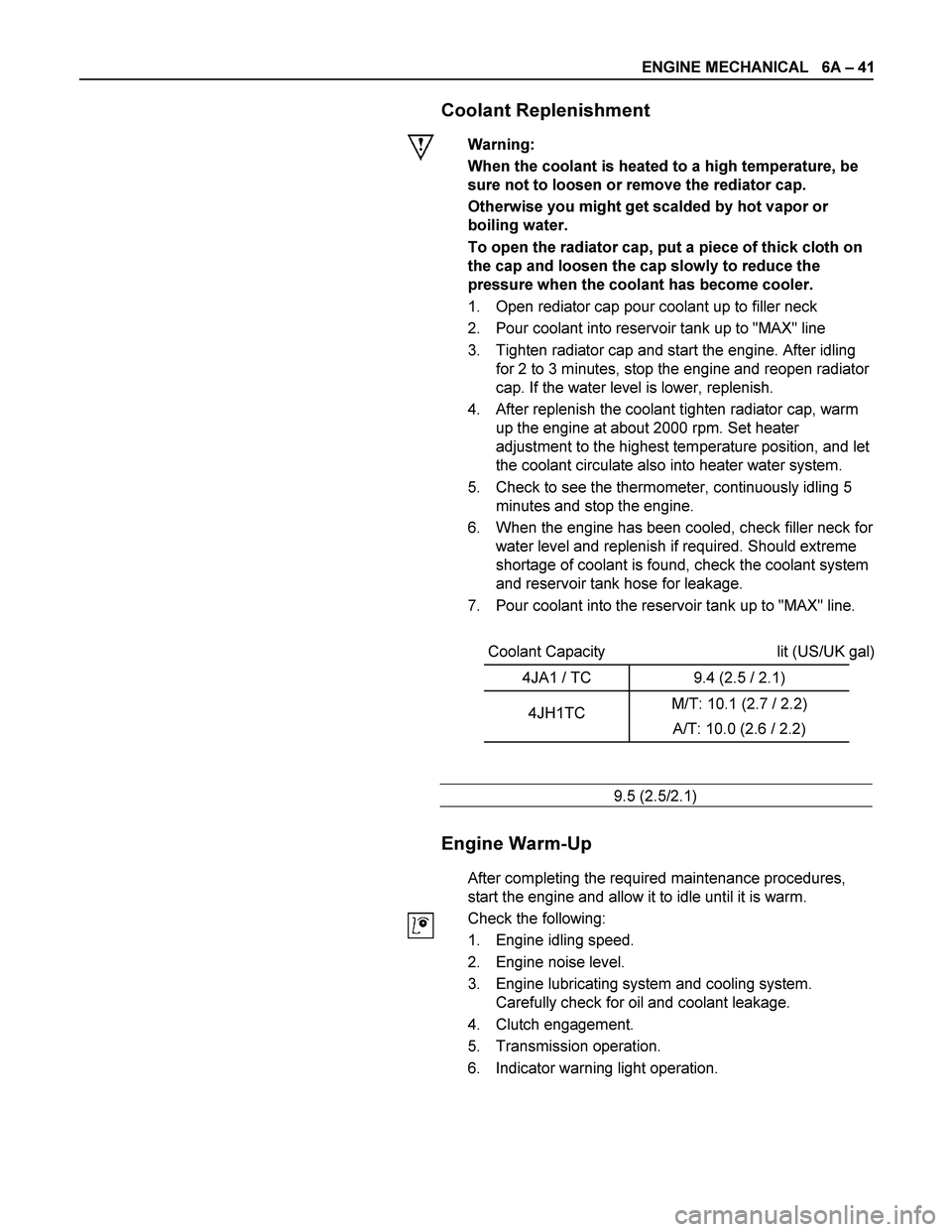
ENGINE MECHANICAL 6A – 41
Coolant Replenishment
Warning:
When the coolant is heated to a high temperature, be
sure not to loosen or remove the rediator cap.
Otherwise you might get scalded by hot vapor or
boiling water.
To open the radiator cap, put a piece of thick cloth on
the cap and loosen the cap slowly to reduce the
pressure when the coolant has become cooler.
1. Open rediator cap pour coolant up to filler neck
2. Pour coolant into reservoir tank up to "MAX" line
3. Tighten radiator cap and start the engine. After idling
for 2 to 3 minutes, stop the engine and reopen radiator
cap. If the water level is lower, replenish.
4. After replenish the coolant tighten radiator cap, warm
up the engine at about 2000 rpm. Set heater
adjustment to the highest temperature position, and let
the coolant circulate also into heater water system.
5. Check to see the thermometer, continuously idling 5
minutes and stop the engine.
6. When the engine has been cooled, check filler neck for
water level and replenish if required. Should extreme
shortage of coolant is found, check the coolant system
and reservoir tank hose for leakage.
7. Pour coolant into the reservoir tank up to "MAX" line.
Coolant Capacity lit (US/UK gal)
4JA1 / TC 9.4 (2.5 / 2.1)
4JH1TC M/T: 10.1 (2.7 / 2.2)
A/T: 10.0 (2.6 / 2.2)
9.5 (2.5/2.1)
Engine Warm-Up
After completing the required maintenance procedures,
start the engine and allow it to idle until it is warm.
Check the following:
1. Engine idling speed.
2. Engine noise level.
3. Engine lubricating system and cooling system.
Carefully check for oil and coolant leakage.
4. Clutch engagement.
5. Transmission operation.
6. Indicator warning light operation.
Page 1283 of 4264
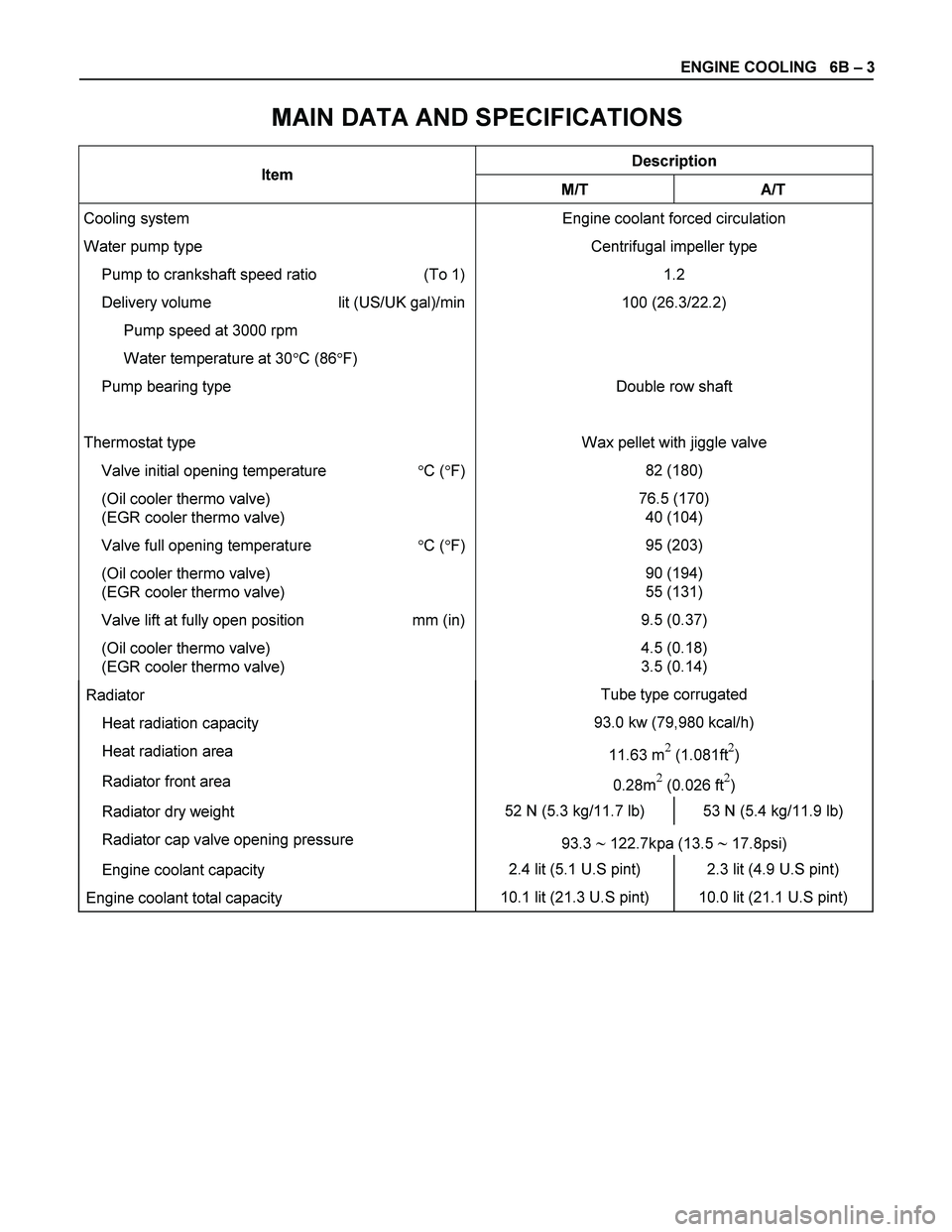
ENGINE COOLING 6B – 3
MAIN DATA AND SPECIFICATIONS
Description Item
M/T A/T
Cooling system
Water pump type
Pump to crankshaft speed ratio (To 1)
Delivery volume lit (US/UK gal)/min
Pump speed at 3000 rpm
Water temperature at 30�C (86�F)
Pump bearing type
Thermostat type
Valve initial opening temperature �C (�F)
(Oil cooler thermo valve)
(EGR cooler thermo valve)
Valve full opening temperature �C (�F)
(Oil cooler thermo valve)
(EGR cooler thermo valve)
Valve lift at fully open position mm (in)
(Oil cooler thermo valve)
(EGR cooler thermo valve) Engine coolant forced circulation
Centrifugal impeller type
1.2
100 (26.3/22.2)
Double row shaft
Wax pellet with jiggle valve
82 (180)
76.5 (170)
40 (104)
95 (203)
90 (194)
55 (131)
9.5 (0.37)
4.5 (0.18)
3.5 (0.14)
Radiator Tube type corrugated
Heat radiation capacity 93.0 kw (79,980 kcal/h)
Heat radiation area
11.63 m� (1.081ft�)
Radiator front area
0.28m� (0.026 ft�)
Radiator dry weight 52 N (5.3 kg/11.7 lb) 53 N (5.4 kg/11.9 lb)
Radiator cap valve opening pressure
93.3 � 122.7kpa (13.5 � 17.8psi)
Engine coolant capacity 2.4 lit (5.1 U.S pint) 2.3 lit (4.9 U.S pint)
Engine coolant total capacity 10.1 lit (21.3 U.S pint) 10.0 lit (21.1 U.S pint)
Page 1287 of 4264
ENGINE COOLING 6B – 7
DIAGNOSIS
Engine Cooling Trouble
Symptom Possible Cause Action
Low Engine Coolant level Replenish
Thermo meter unit faulty Replace
Faulty thermostat Replace
Faulty Engine Coolant temperature
sensor Repair or replace
Clogged radiator Clean or replace
Faulty radiator cap Replace
Low engine oil level or use of
improper engine oil Replenish or change oil
Clogged exhaust system Clean exhaust system or replace
faulty parts
Faulty Throttle Position sensor Replace throttle valve assembly
Open or shorted Throttle Position
sensor circuit Repair or replace
Engine overheating
Damaged cylinder head gasket Replace
Engine overcooling Faulty thermostat Replace
Faulty thermostat Replace Engine slow to warm–up
Thermo unit faulty Replace
Page 1288 of 4264
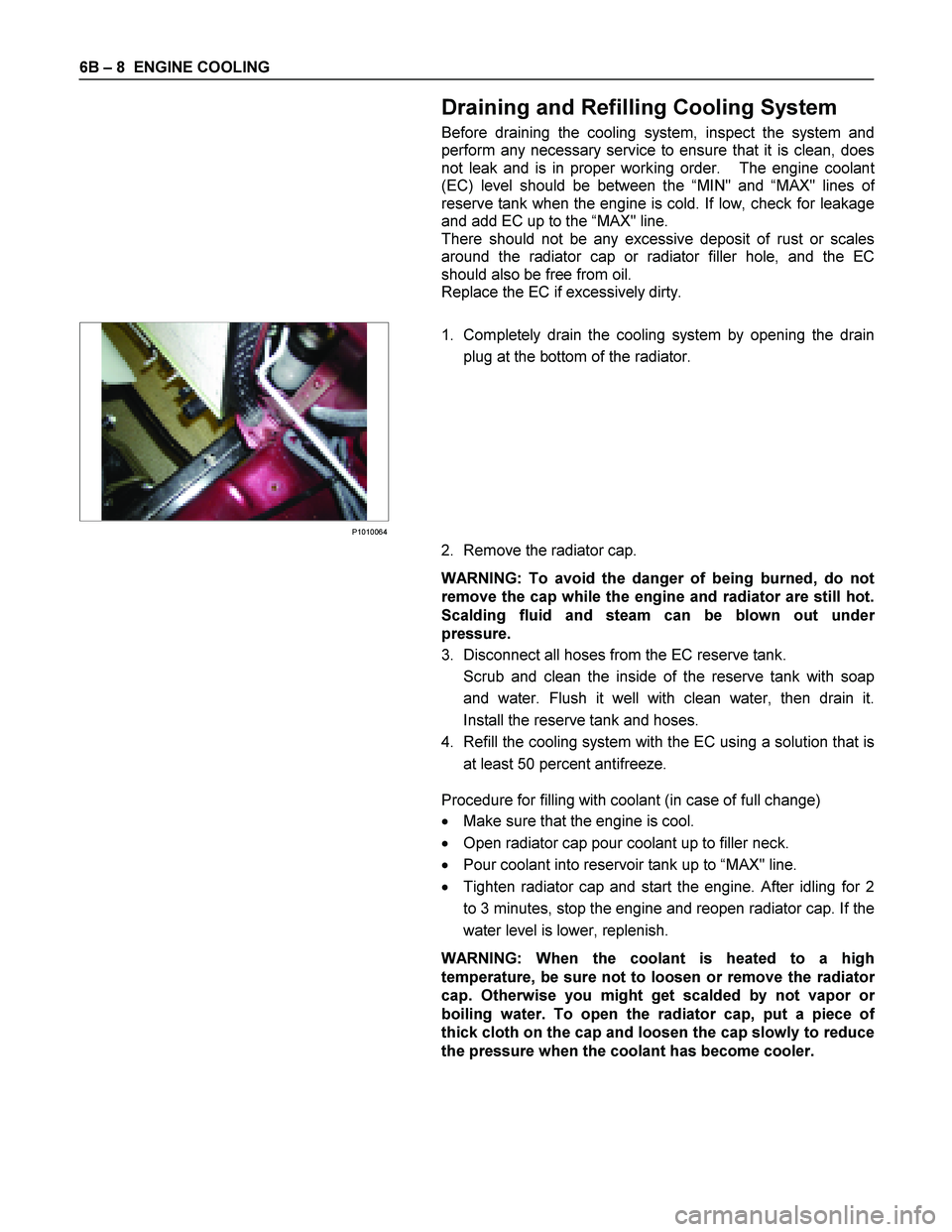
6B – 8 ENGINE COOLING
Draining and Refilling Cooling System
Before draining the cooling system, inspect the system and
perform any necessary service to ensure that it is clean, does
not leak and is in proper working order. The engine coolan
t
(EC) level should be between the “MIN" and “MAX" lines o
f
reserve tank when the engine is cold. If low, check for leakage
and add EC up to the “MAX" line.
There should not be any excessive deposit of rust or scales
around the radiator cap or radiator filler hole, and the EC
should also be free from oil.
Replace the EC if excessively dirty.
P1010064
1. Completely drain the cooling system by opening the drain
plug at the bottom of the radiator.
2. Remove the radiator cap.
WARNING: To avoid the danger of being burned, do not
remove the cap while the engine and radiator are still hot.
Scalding fluid and steam can be blown out unde
r
pressure.
3. Disconnect all hoses from the EC reserve tank.
Scrub and clean the inside of the reserve tank with soap and water. Flush it well with clean water, then drain it.
Install the reserve tank and hoses.
4. Refill the cooling system with the EC using a solution that is at least 50 percent antifreeze.
Procedure for filling with coolant (in case of full change)
� Make sure that the engine is cool.
� Open radiator cap pour coolant up to filler neck.
� Pour coolant into reservoir tank up to “MAX" line.
� Tighten radiator cap and start the engine. After idling for 2
to 3 minutes, stop the engine and reopen radiator cap. If the
water level is lower, replenish.
WARNING: When the coolant is heated to a high
temperature, be sure not to loosen or remove the radiato
r
cap. Otherwise you might get scalded by not vapor or
boiling water. To open the radiator cap, put a piece of
thick cloth on the cap and loosen the cap slowly to reduce
the pressure when the coolant has become cooler.